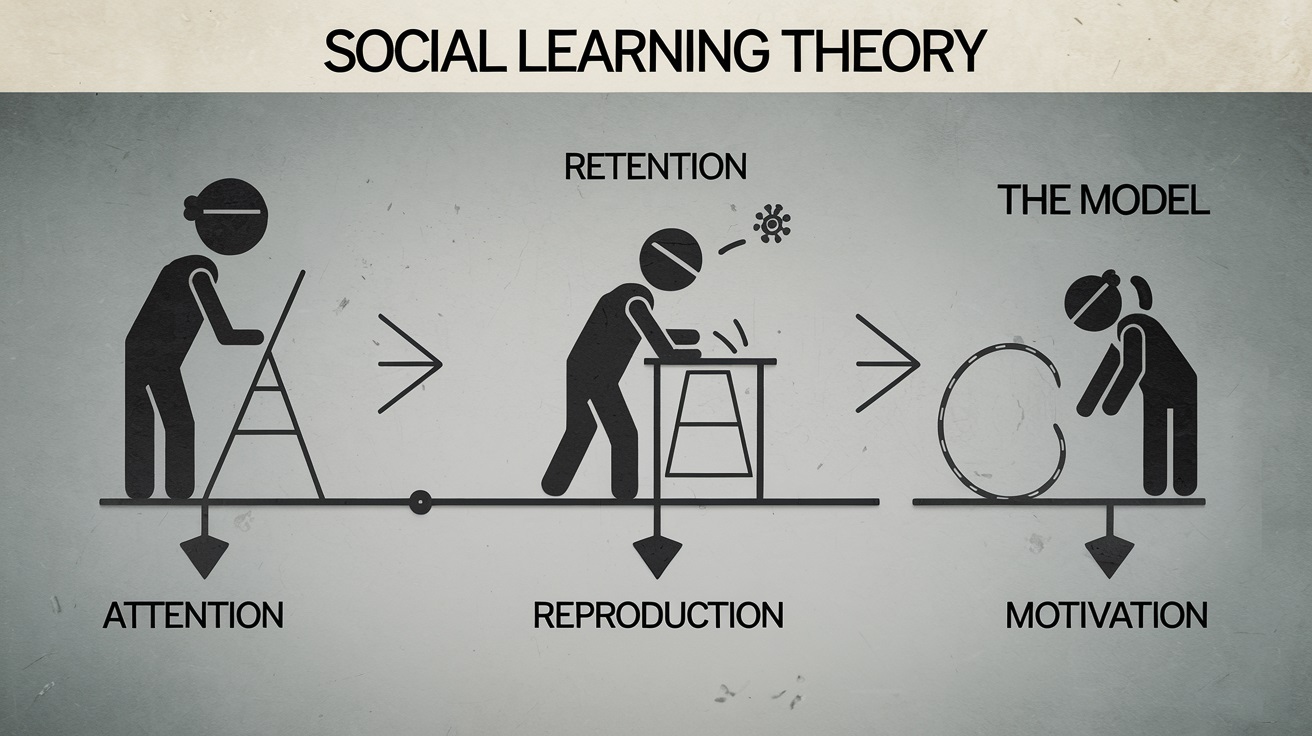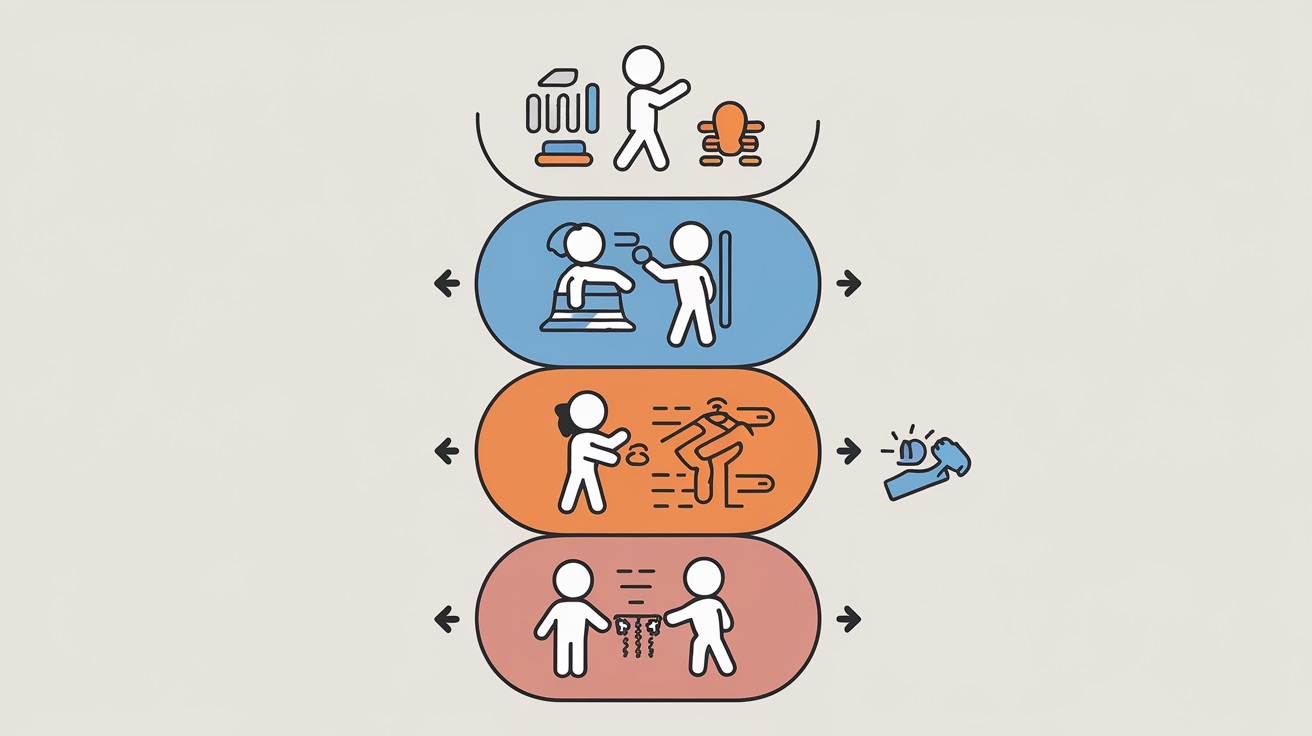
Social Learning Theory: Understanding the Four Processes for Effective Learning
Understanding how individuals learn by observing others is essential in many aspects of life, from classrooms and workplaces to everyday social interactions.
Learning by observation is at the core of social learning theory, introduced by Albert Bandura. Unlike traditional models emphasizing learning through direct experience, social learning theory highlights that much of human behavior is acquired through watching others.
This theory is a cornerstone in psychology and has far-reaching applications, especially in education, training, and even digital learning environments.
This article explores the four processes central to social learning theory—attention, retention, reproduction, and motivation—and their real-world applications. We will detail each process, making complex ideas simple to understand. By the end of this article, you’ll have a comprehensive understanding of how social learning theory works and how to apply it effectively in various settings.
What is social learning theory?
Social Learning Theory is a psychological framework explaining how people learn new behaviors by observing others. Developed by Albert Bandura in the 1970s, this theory emphasizes that learning can occur even without direct reinforcement. Instead, individuals can observe the actions of others, remember what they see, and decide whether to replicate the observed behavior based on the perceived consequences.
Bandura’s groundbreaking research, notably his Bobo Doll experiment, provided empirical evidence for this theory. In the experiment, children watched adults interacting aggressively with a Bobo doll.
Many of these children imitated the aggressive behaviors they had observed when given the opportunity. This demonstrated that observation alone could lead to learning, challenging the idea that behavior change only happens through direct reinforcement.
Social learning theory differs from behaviorism in significant ways. While behaviorism focuses on direct reinforcement—the idea that behaviors are shaped by rewards or punishments—social learning theory introduces the concept of observational learning.
This means that people can acquire new behaviors simply by watching others, even if they do not receive immediate rewards or penalties. For example, a child might learn how to tie their shoelaces by watching a parent do it, even without being taught.

Breakdown of the Four Processes
The core of social learning theory lies in four interconnected processes that help people learn through observation: attention, retention, reproduction, and motivation. Each process plays a vital role in how we absorb and replicate behaviors we observe.
Process 1: Attention
Attention is the first step in learning through observation. For a behavior to be understood, the observer must focus on the displayed behavior. This process determines which behaviors are noticed and remembered amid countless distractions.
Attention involves the ability to concentrate on the behavior being modeled, which allows the observer to recognize and understand the critical elements of the action.
Factors Influencing Attention:
Various factors influence an individual's attention to behavior.
These include:
-
Interest level: People are more likely to pay attention to behaviors that interest or are relevant to their needs.
-
Model characteristics: Observers are often more engaged when the model is perceived as similar to themselves, authoritative, or attractive.
-
Novelty and complexity: New or unusual behaviors can capture attention more efficiently than familiar ones.
Consider a classroom setting where students are likelier to pay attention to a teacher who uses engaging storytelling and visual aids to explain a concept. This makes the learning process more enjoyable and memorable.
Educators can improve students' attention by using interactive teaching methods, maintaining eye contact, and relating lessons to real-life scenarios that interest the learners.
Process 2: Retention
After capturing attention, the next step is retention—the process of remembering the observed behavior. Remembering the behavior when needed is impossible without memory.
Retention is how well someone remembers observed information. Translating observation into long-term memory is crucial to replicating the behavior later.
Techniques for Retention:
Several methods can enhance retention, such as:
-
Visualization: Creating mental images of the observed behavior helps solidify it in memory.
-
Rehearsal: Mentally rehearsing or repeating the behavior can strengthen memory retention.
-
Associative learning: Connecting new behaviors with existing knowledge makes remembering them more manageable.
Professional athletes often use video analysis to observe their techniques. Visualizing their movements and mentally rehearsing improvements enhance their ability to replicate them during practice.
Teachers can boost retention by encouraging students to use mind maps, summary notes, or group discussions reinforcing key concepts.
Process 3: Reproduction
In reproduction, the observer copies the learned behavior. It involves translating what is retained in memory into action.
Reproduction involves the physical and cognitive ability to imitate the observed behavior. It requires the observer to have the necessary skills to reproduce the behavior accurately.
Skill level and practice:
The ability to replicate a behavior depends on the following:
-
Physical ability: Some behaviors require specific physical skills, such as learning a dance move.
-
Cognitive ability involves understanding the steps and mentally processing the behavior before attempting it.
-
Practice: Repeated practice can help refine the ability to perform the behavior more accurately.
A student might observe a mathematics demonstration in class but needs repeated practice to solve similar problems independently.
Trainers and educators can support reproduction by providing guided practice, hands-on activities, and step-by-step instructions to help learners master their observation skills.
Process 4: Motivation
The final process, motivation, determines whether the observer desires to reproduce the observed behavior. With motivation, even well-learned behaviors may be replicated.
Motivation involves the reasons behind the decision to adopt or discard the observed behavior. It is influenced by the potential rewards or punishments associated with the behavior.
Types of Motivation:
-
Intrinsic motivation comes from personal satisfaction or enjoyment.
-
Extrinsic motivation: This is driven by external rewards or incentives, such as praise, grades, or monetary rewards.
Students are often more motivated to complete assignments when they receive positive feedback or extra credit.
Managers can encourage desired behaviors in a work environment by offering recognition programs, bonuses, or career growth opportunities.
Real-Life Applications of Social Learning Theory
Understanding how social learning works allows us to apply its principles in various aspects of life, making learning more effective and engaging.
In Education
Social learning theory is widely used in educational settings to foster a positive learning environment. Teachers often serve as role models, and their behavior can significantly influence how students interact, learn, and grow.
Teachers can demonstrate problem-solving techniques, effective communication, and empathy to help students develop these skills.
Role-playing activities are particularly effective in teaching social skills and conflict resolution. By watching these demonstrations, students learn how to manage similar situations.
Teachers can integrate peer teaching and collaborative learning methods, encouraging students to learn from one another and reinforcing social learning principles.
In Workplace Training
In the professional world, social learning theory is often applied to mentorship programs, training sessions, and corporate culture development. New employees learn best when they observe experienced colleagues.
Mentors act as role models, guiding newcomers through the norms, values, and skills required in the workplace.
A new employee might learn how to handle complaints by observing a senior colleague’s approach, including tone, language, and body language.
Employers can create opportunities for job shadowing and peer observation to facilitate the transfer of knowledge and skills between team members.
In Digital Learning Environments
Social learning theory has adapted to virtual spaces with the rise of online learning platforms and digital collaboration tools.
Online courses and communities enable users to learn by observing peers, participating in discussions, and sharing knowledge.
Online courses often include discussion forums and group projects, encouraging students to share their understanding and learn from others.
Digital learning platforms can mimic in-person observational learning via video tutorials, live demonstrations, and peer feedback systems.
Common misconceptions about social learning theory
Misconception 1: “Social learning is the same as direct learning.”
Social learning emphasizes learning through observation rather than direct experience. For example, a child may learn how to ride a bike by watching a friend, even before trying it themselves.
Misconception 2: “Social learning only happens in children.”
While children are highly influenced by their surroundings, adults continue to learn through observation, especially in new workplaces or social settings.
Misconception 3: “Reinforcement isn’t necessary in social learning.”
While initial learning can occur without reinforcement, rewards and motivation are crucial in whether the behavior is repeated or abandoned.
Key Takeaways
-
Social-Learning Theory offers a framework for understanding how we learn from observing others.
-
The four processes—attention, retention, reproduction, and motivation—are essential for effective learning.
-
Applications span classroom settings, workplace training, and digital learning environments.
-
Recognizing these processes can enhance teaching strategies, training programs, and personal growth.
Conclusion
Understanding social learning theory can transform how we approach teaching, training, and self-improvement. We can create highly effective and engaging learning environments by recognizing how attention, retention, reproduction, and motivation shape our learning experiences. Whether you’re a teacher aiming to inspire students, a manager developing a training program, or simply someone eager to understand human behavior, social learning principles can be a powerful tool for growth.
Take these insights and start applying them in your daily interactions. You may be surprised at how much you can learn—and teach—by observing the world!
Education Study Tips

